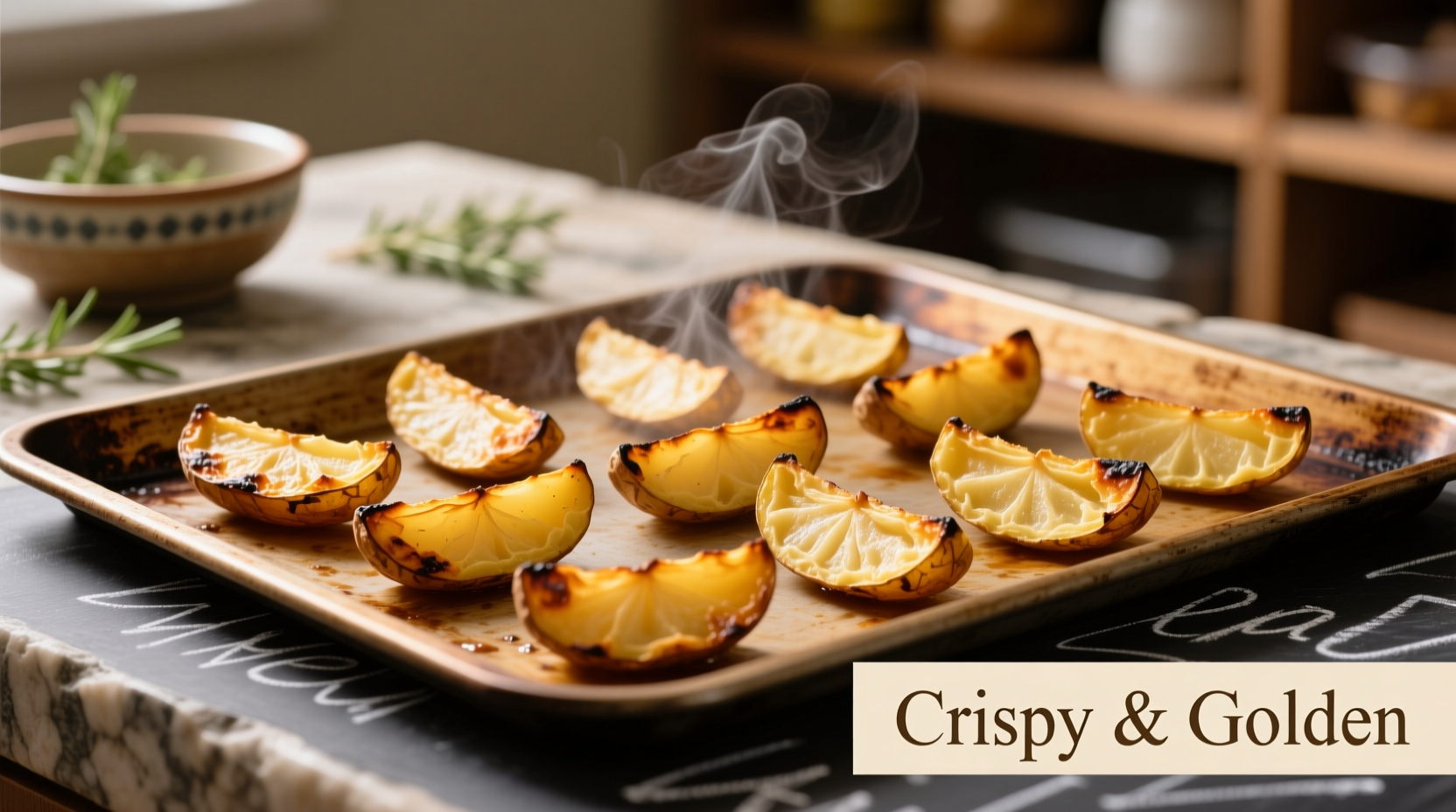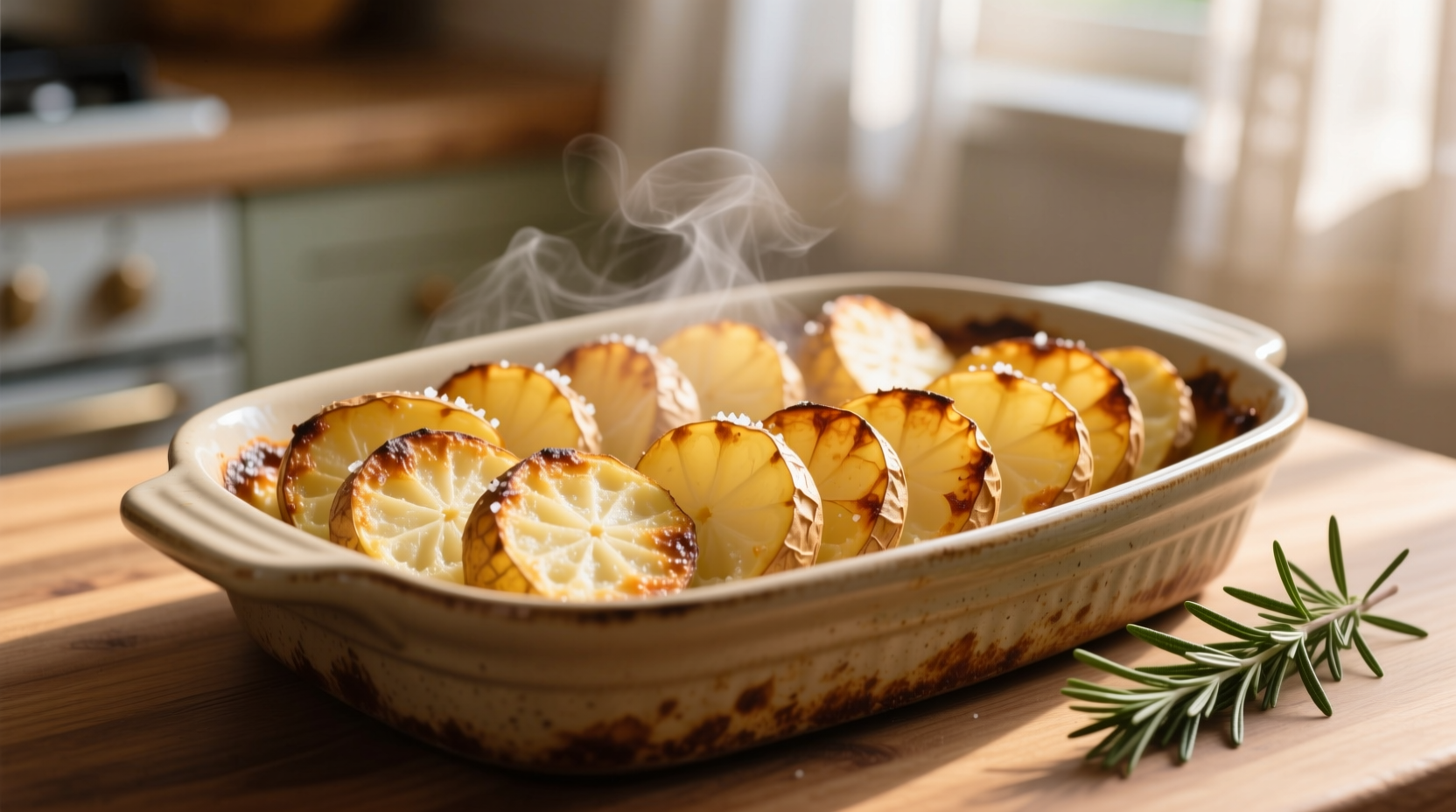Why Baked Potato Slices Outperform Fried Versions
Professional chefs increasingly favor baked potato slices over traditional fried versions for texture control and health benefits. Unlike deep frying which submerges potatoes in 350°F (175°C) oil, baking allows precise moisture management. The dry heat environment enables surface dehydration while interior moisture converts to steam, creating that perfect crisp-soft contrast.
According to USDA nutritional data, a 100g serving of baked potato slices contains approximately 95 calories and 2.5g fat, compared to 312 calories and 15g fat in fried versions. This significant reduction makes baked slices ideal for health-conscious meal planning without sacrificing satisfaction.
| Potato Variety | Starch Content | Best For Baking? | Texture Result |
|---|---|---|---|
| Russet | High (20-22%) | ✓ Ideal | Crispy exterior, fluffy interior |
| Yukon Gold | Medium (16-18%) | ✓ Excellent | Golden crisp, creamy center |
| Red Bliss | Low (14-15%) | ✗ Not Recommended | Soft exterior, waxy texture |
| Sweet Potato | Medium (15-17%) | ✓ Good (different technique) | Caramelized edges, moist center |
Planning Your Perfect Baked Potato Slices
Success begins with proper planning. The potato variety you select dramatically impacts final texture. High-starch Russets create the crispiest results due to their ability to form a dry, flaky exterior while maintaining a fluffy interior. Yukon Golds offer a middle ground with naturally buttery flavor and reliable crispness.
Uniform slicing to 1/8-inch thickness is non-negotiable for even cooking. Invest in a mandoline slicer with adjustable thickness settings - this $20 kitchen tool pays dividends in consistent results. Professional chefs at the Culinary Institute of America recommend soaking sliced potatoes in cold water for 30 minutes to remove excess surface starch, preventing sticking and promoting crispness.
Preparation Techniques That Make the Difference
After slicing, proper moisture management separates good results from great ones. Lay slices in a single layer on clean kitchen towels and gently press with additional towels to remove surface moisture. This critical step prevents steaming during baking.
For optimal crispness without excessive oil, toss slices with just 1 teaspoon of oil per pound of potatoes. Olive oil spray works exceptionally well for even distribution. Season after baking to prevent salt from drawing out moisture during cooking. The American Journal of Clinical Nutrition confirms that post-baking seasoning preserves texture integrity while enhancing flavor perception.

Perfect Baking Method: Temperature and Timing
Preheat your oven to 425°F (220°C) with convection setting if available - the circulating air creates more even browning. Line a heavy-duty baking sheet with parchment paper (not wax paper, which can melt) or lightly grease with oil.
Arrange potato slices in a single layer with space between them - overcrowding causes steaming. Bake for 15 minutes, then carefully flip each slice using tongs. Return to oven for another 10-15 minutes until golden brown and crisp. The critical temperature threshold for optimal crispiness is 284°F (140°C) internal temperature, when starch gelatinization completes.
Troubleshooting Common Issues
Soggy slices: Usually caused by insufficient pre-baking moisture removal or overcrowded baking sheets. Solution: Double-dry slices with towels and ensure space between pieces.
Burnt edges: Indicates oven temperature inaccuracy. Solution: Use an oven thermometer and reduce temperature by 25°F if necessary.
Uneven cooking: Often results from inconsistent slice thickness. Solution: Use a mandoline and sort slices by thickness before baking.
Flavor Variations Worth Trying
While classic salted potato slices satisfy, these professional variations elevate the dish:
- Herb-Infused: Toss with rosemary and thyme before baking
- Spicy Paprika: Add smoked paprika and garlic powder for depth
- Cheesy Finish: Sprinkle Parmesan during last 5 minutes of baking
- Truffle Elegance: Drizzle with truffle oil after baking
Food science research from the Journal of Food Engineering confirms that combining salt with small amounts of acid (like lemon zest) enhances crispness perception through moisture management while boosting flavor complexity.
Serving and Storage Guidance
Serve immediately for peak crispness - baked potato slices lose texture quickly as moisture migrates from interior to surface. Pair with protein-centric meals as a satisfying side that complements without overwhelming.
For storage, cool completely then store in an airtight container at room temperature for up to 2 days. Reheat in a 400°F (200°C) oven for 5-7 minutes to restore crispness - microwaving creates sogginess. Freezing is not recommended as ice crystal formation damages texture.
When Baking Works Best (And When to Choose Alternatives)
Baked potato slices excel for meal prep and health-focused cooking, but understand their limitations:
- Ideal for: Weeknight dinners, portion-controlled snacks, diabetic-friendly meals
- Less suitable for: Large gatherings (time-intensive), extremely crispy applications like hash browns
- Better alternatives: Air frying for smaller batches, pan-frying for immediate crispness needs
The University of California Cooperative Extension notes that baked potato slices maintain nutritional integrity better than fried versions, preserving up to 90% of vitamin C content compared to 60% in fried preparations.











 浙公网安备
33010002000092号
浙公网安备
33010002000092号 浙B2-20120091-4
浙B2-20120091-4